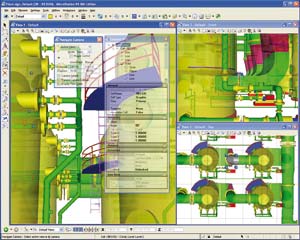Intel expanding open-source rendering and ray-tracing libraries to encourage software developers to come on board
Intel is expanding the capabilities of its oneAPI Rendering Toolkit as it looks to encourage CAD, M&E and gaming / XR software developers to use its open-source rendering and ray-tracing libraries in their products.
New additions due to launch soon include Intel OSPRay Studio, a scene graph application designed to make it easier to develop ‘high fidelity ray traced, interactive, real time rendering tools’, and Intel OSPRay for Hydra, which uses the Universal Scene Description (USD) format to deliver a viewport focused renderer. USD was originally developed by Pixar for use in visual effects and animation but is starting to gain traction in other industries including architecture and forms the backbone to Nvidia’s new Omniverse collaboration platform.
Intel has been ramping up the development of its rendering libraries for some years now and there are currently five in the oneAPI Rendering Toolkit. The ones most relevant to design visualisation are Intel Embree, which helps developers get more performance out of their ray tracing applications and Intel OSPRay, a higher level ray tracing API, akin to OpenGL, for developing interactive visualization applications. There’s also Intel Open Image Denoise, which improves image quality with machine learning algorithms that selectively filter visual noise.
The main driving force behind this expansion is, of course, for Intel to sell more processors. But this isn’t just Intel Core and Intel Xeon CPUs. Later this year Intel will release the first products in its new Intel Xe Graphics family which will eventually cover mobile, desktop, workstation and datacentre. In the past, Intel has focused mainly on the entry-level, with integrated graphics built into its CPUs. However, many of the new Intel Xe Graphics will be discrete GPUs, some of which will support hardware ray tracing to go head to head with AMD and Nvidia.
Of course, to sell hardware, there has to be software to run on it, and while Intel has done exceedingly well in CPU rendering over the years it is now facing stiff competition from GPU renderers powered by Nvidia and AMD technology.
Nvidia is arguably Intel’s biggest threat – not least because it has very powerful RTX GPUs with built in hardware ray tracing and AI de-noising, but also because applications that use its OptiX ray tracing API or Nvidia Iray rendering engine require an Nvidia CUDA-capable GPU, which mean Intel gets firmly shut out.
AMD, on other hand, has gone down the open source route and its Radeon ProRender rendering engine uses OpenCL so will run on any hardware.
Nvidia also has the advantage of there being many applications that use its proprietary software technology. In product design, engineering and architecture, for example, developers include Altair, Autodesk, Chaos Group, DS Solidworks, ESI, Foundry, Luxion (KeyShot), Unity and others.
Intel has its own list of third party applications that use its libraries, including V-Ray and Corona Renderer (Chaos Group), Cinema4D (Maxon), AutoCAD, 3ds Max, Revit (Autodesk) and Stellar / Deltagen (Dassault Systèmes). However, the libraries used in these applications currently relate to CPUs, and it’s not clear if support in all of these applications will extend to Intel’s full XPU platform, where XPU is short for CPUs, GPUs, FPGAs and other processors.

Intel’s oneAPI is designed to be flexible and scalable, as Jim Jeffers. Sr. Principal Engineer, Sr. Director, Advanced Rendering and Visualisation at Intel explains “The idea is smart software can take advantage of the platform it’s presented with, whether it’s a laptop or a supercomputer. Our goal is to support any workload at any size at any scale, especially with our rendering capability.”
Jeffers points out that by using oneAPI ISVs can develop for multiple platforms without having to have multiple code bases. This single API approach might work for some software developers, but for others it would mean dropping Nvidia Optix, which seems unlikely considering the momentum behind it.
Software developers are also not averse to supporting multiple rendering engines. Chaos Group V-Ray and Luxion KeyShot can both use CPUs and GPUs, and Solidworks Visualize actually offers a choice of two GPU rendering engines – Nvidia Iray and AMD Radeon ProRender.
AMD or Nvidia could in theory choose to add support for Intel’s oneAPI. “It’s an open specification, and we are willing to work with and encourage hardware vendors to apply that, and we also believe that the market will ask them to do that as well, but it is for them to optimise,” says Jeffers.
At the moment it seems highly improbable that Nvidia would do this, considering the penetration of its ray tracing software. It seems more likely that AMD would go down this route, but AMD will be well aware that open source from Intel isn’t the same as an open standard from a third party like the Khronos Group, who develops OpenGL, OpenCL, WebGL and Vulkan.
Of course, all of this will depend on how successful Intel is with getting software developers on board and also how well it does with Intel Xe Graphics. This is not the first time that Intel has tried to take on AMD and Nvidia in the discrete graphics market, with its ill-fated Larrabee project many years ago. We should find out more when Intel Xe Graphics launches later this year.
If you enjoyed this article, subscribe to our email newsletter or print / PDF magazine for FREE







